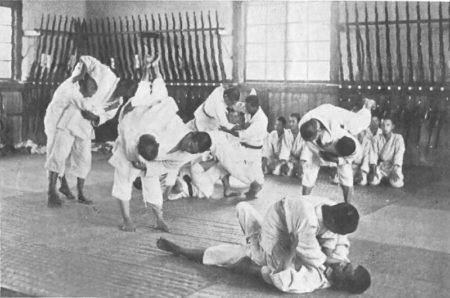邮购柔术中 1921
一月份印刷了一则广告 16, 1921 版的 圣. 圣路易斯邮报 从Capt上宣传Jujitsu的邮购课程. 艾伦·史密斯. 上尉. 史密斯(Smith)最初出生于苏格兰,但对日本柔术的表演着迷 (实际上柔道) 他在英格兰见过. 史密斯与一家公司一起前往日本,并学会了柔道达到一级黑带.
史密斯几年后将前往美国,并开始向美国教授这些技术. 军队. 史密斯还开始出售邮购课程, 摔跤手和身体文化家中相当普遍的做法.

Jujitsu Practice at a Japanese Agricultural School in 1922 (公共领域)
史密斯(Smith)的广告在您学会了Jujitsu的技巧和秘密之后声称, 你可以轻松击败一个巨人. 女人可以克服任何ruffian 100 他们反对的力量的百分比 20 攻击者的力量百分比. 史密斯的广告还声称他对艺术的指导是优越的,因为日本老师没有解释为什么技巧或技巧有效. 史密斯确实解释了 “tricks”.
“柔术的秘密” 书包含 59 经验教训 253 插图. 利益学生不必汇款即可接受课程. 他们只需要将优惠券邮寄到哥伦布的Stahara Publishing Company, 格鲁吉亚.
学生有 5 审查材料并将其发送回或发送的日子 $5.00 全额付款. 在 2020 美元, 课程将花费 71 美元. 变得无敌.
上尉. 史密斯的广告代表了某种类型的营销, 在20世纪很受欢迎. 在每本杂志和报纸上,几乎所有内容的邮购课程都是常见的. 他们充满了许多关于殴打恶霸的狂野主张, 发展大肌肉或成为百万富翁. 由于广告法中的真相,我们不再看到许多这些广告.
我不能如果上尉. 史密斯正在做广告或他的出版商. 我没有听说过上尉. 史密斯直到我找到这个广告, 在研究与专业摔跤手竞争的柔术战斗机的同时.
In reality, 几乎所有这些 “柔术” 战士是吉加罗·卡诺(Jigaro Kano)派出的柯多坎黑带,以散布柔道. jujitsu老师没有自由地分享他们的知识. 博士. 卡诺是一个例外. 上尉. 史密斯是柔道黑带, 前往美国传播艺术的人.
由于薪水被Kodokan禁止, 可能是Fighers使用Jujitsu试图与Kodokan避免麻烦. 更有可能, 柔道和柔术术语当时互换使用.
柔道很新, 尤吉苏在日本更加建立. 在大多数武术史上都存在如此多的夸张和夸张, 很难知道练习背后的真正原因.
You can leave a comment or ask a question about this or any post on my Facebook页面.
Sources: 圣. 圣路易斯邮报, 一月 16, 1921 版, p. 93 和 非致命战斗性杂志, 六月 2003.
Pin It

